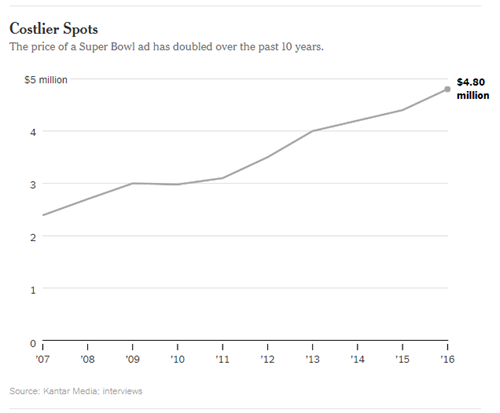Is It Still Worth It To Buy a Super Bowl TV Ad?
Despite the NFL’s television ratings having dropped in 2017 for the second straight year, the  Super Bowl still remains by far one of the biggest advertising events of the year. Last year, roughly 80 national commercial slots were sold, and this year, the spots are nearly sold out for Super Bowl LII. According to the figures from Kantar Media, in-game advertising generated $2.6 billion in sales to networks between 2007 and 2016.
Super Bowl still remains by far one of the biggest advertising events of the year. Last year, roughly 80 national commercial slots were sold, and this year, the spots are nearly sold out for Super Bowl LII. According to the figures from Kantar Media, in-game advertising generated $2.6 billion in sales to networks between 2007 and 2016.
However, the way marketers are launching their ad campaigns has been drastically changing since 2011. It appears that more and more brands have begun utilizing the tactic of “building buzz” in the lead up to the game to achieve a greater return on investment. Given that a 30-second spot now costs $5.2 million, and there has been an ongoing explosion in the volume of channels to engage with audiences, some marketers have started developing a holistic omnichannel strategy to supplement this expensive TV spot with, while some other marketers have decided to opt out of Super Bowl commercials to allocate their marketing budgets in more diverse ways, rather than putting all their eggs in one basket.

Social Media Is Off the Bench
As of January 1st, large brands that purchased a TV spot during the game have been launching the news releases, media previews or exclusive sneak peeks to create some sense of anticipation in an effort to extend the lifespan of their marketing campaigns before and after the game.
Last year for instance, Buick, a stylish, luxury vehicle maker, didn’t release anything about its first Super Bowl ad until its debut. However this year, the company announced that they would release the ad early and double the budget spent last year on social media promotions. Releasing the ad early “gives us a longer time span to engage consumers, and I believe it’s a better return on our investment,” said Molly Peck, Buick’s director of marketing, adding that the company wanted to match the interest it generated last year for being a first-time advertiser.
To satiate the emerging influence of social media in the Super Bowl and to get a larger slice of the pie, Twitter is making a smart move this year with rolling out the “first ever social subscription for users to get TV spots delivered to them on Twitter.” The social media giant calls it #BrandBowl which is an exclusive place that gathers brands and users through a subscription expiring as soon as the event is over. How does it work? Simple. Users will opt-in by retweeting a tweet from Twitter’s marketing account (@TwitterMKTG) any time after January 29 to receive a blend of real-time notifications and summary videos after each quarter with video of each ad. “This is a mechanism for users to say, ‘Hey, I’m interested in this, send me more content,” Ryan Oliver, Twitter’s head of brand strategy for the U.S. and Canada, commented. “We could see this being used for other big tentpole events.”
However, what’s even more brilliant about this idea is that the #BrandBowl will hand out awards for ads, and one of the awards will be given even to a brand without a national TV spot that drove the highest percentage of brand conversation. It is an incredible opportunity for a brand that can capture huge traction on Twitter without pouring millions of dollars into a TV spot. Given Oreo shone its light on the marketing world by taking advantage of a 34-minute power outage during the game in 2013, sometimes, all it takes is a witty and timely tweet:
From Twitter’s perspective, this new online subscription model is a great opportunity to leverage the growth in Twitter video, both in overall consumption and as a component in Twitter advertising campaigns.
The Super Bowl-Specific Reasons to Fully Embrace Social Media
Today, not to include social media into any marketing campaign and omnichannel marketing strategy is obviously out of the question. However, in the case of the Super Bowl, there are specific trends that put social media in an even higher position in brands’ marketing strategies.
One of the most critical factors is the steep decline in traditional TV consumption despite the huge spike in video content consumption, considering TV is still the largest video source (for now). TV ads are losing ground to YouTube at a rapid rate. As an advertising platform, YouTube has a reach of over 1 billion views per day, and it has an extremely engaged user base with 95% advertising viewability and 95% advertising audibility. This number is only expected to rise as more and more users join the platform. Another study has predicted that by 2019, the number of YouTube users in the United States will rise to 187.8 million, up from 170.7 million in 2015.
Another trend to consider is that many multitasking fans watch the game on their TVs while using other connected devices simultaneously. In 2016, there were 46.7 million simultaneous internet and TV adult users in the United States, and that's projected to increase to 54.2 million adult users in 2018. This makes it even more critical that social networks should be heavily involved in the Super Bowl ads, not only before and after but also in real time. Speaking of distracting habits, a recent study found that more than 80% of Centennials (under the age of 21) value social media when it comes to making a purchase decision, while Millennials (ages 22 to 37) want to have all channels aligned and consistent.
Although the majority of viewership comes from the U.S., there is still a big fan base outside of the States. Due to some country’s laws and regulations, some viewers tuning into the game outside of the U.S may not be exposed to the Super Bowl commercials. In Canada, for instance, there has been a practice called simultaneous substitution, aka “SimSub”, which allows broadcasters who air American programming (such as CTV or Global) to request distributors (such as Bell or Rogers) to switch over to a Canadian signal — and Canadian ads — during commercial breaks. Given 9.2 million viewers watched last year’s game on Canadian rights holder Bell Media’s CTV and French-language affiliate RDS, this is a large chunk of lost audience. This year, this ban might be lifted but there has still been controversy around the matter.
Why Wix Opted Out of Super Bowl Advertising
Not every brand returns to the Super Bowl and combines TV and digital channels more tightly. Wix, the DIY website builder, for instance, announced that they wouldn’t purchase a Super Bowl TV spot this year, after running Super Bowl ads over the last three years. More interestingly, their CMO explained that it was not for lack of budget and admitted that the marketing budget had in fact increased. It cannot be because of failed experiences from the previous years either as its brand awareness has skyrocketed over a span of three years, with 22.6 million digital and social views accumulated.
Then, what was the rationale behind dropping the Super Bowl this year? In a nutshell, Wix executives feel that they could achieve greater ROI through other channels. While the brand continues to have small businesses as their target audience, it will also be actively targeting developers and designers due to its new expansion. Now that the Super Bowl is off the table for 2018, Wix will shift that budget towards its efforts on digital campaigns and further segmentation to the new audiences, as well as doing more in global markets. To that end, this year’s boosted marketing budget will be spent on partnerships with fashion model Karlie Kloss, internet comedians Rhett and Link and YouTube influencer iJustine, as well as with the New York Yankees and Brazilian soccer team Flamengo.
Although Wix has seen a remarkable growth in both revenue and audience reach through its Super Bowl campaigns, putting all their eggs in one basket doesn’t make sense this time, especially given their biggest markets now include Brazil and other South American countries more than the U.S. After all, you know how the saying goes “if it worked yesterday, it probably won’t work tomorrow.”
The CEO of PK4 Media, which runs omnichannel advertising campaigns for many Fortune 500 companies, commented on how digital and social went from complementary to the primary tactical method for some brands like Wix: “I believe the Wix.com example is a microcosm of the evolution taking place in the advertising industry. I find it fascinating that in 2011 digital Super Bowl advertising was a novelty, by 2015 it was a necessary complement to any TV spot, and today, at least one brand is willing to forgo TV and invest solely in a digital and social strategy.” He also added: “No campaign can be fully maximized if it is not supported by a holistic omnichannel strategy.”
On a side note, if a brand like Wix decides to allocate the same marketing budget with the Super Bowl differently, digital marketers could get 2.6 million clicks on Amazon or 2.6 million impressions on Instagram with a Super Bowl ad budget of $5.2 million, claims Digiday in an article. Not fancy enough? Well, with even slightly under this budget, a brand apparently could purchase eight Instagram posts from Selena Gomez, according to the Digiday article.
My POV
Although the Super Bowl still remains to be a rare opportunity for brands to reach more than 100 million viewers in a day, merely relying on that national TV spot or throwing a couple of tweets before and after won’t cut it anymore.
As we always discuss here at CMS-Connected, the competition for people’s attention has never been more fierce. With the advent of technology, it may be a great time to be a digital content marketer but it is hard to say the same for garnering attention from a target audience. Given there are already so many spots in a Super Bowl, it is hard to stand out. Therefore, building a holistic strategy that positions a brand in advance of the game is immersive to achieve a return on investment.
Considering how much brands pay for a national TV spot as well hiring celebrities to act in those commercials, underestimating the impact that the digital and social marketing efforts would be a huge mistake. Dispersing big advertising bucks on big events like the Super Bowl or in a Hollywood movie may bring huge exposure to the brand in a short span of time. However, it doesn’t guarantee the same for the lifespan of its impact as brands may end up having a successful one-hit commercial that is yet another flash in the pan. Therefore, just like Wix’s marketing executives, marketers should always stay on top of emerging trends and never get tired of experimenting with new channels and combinations.

Venus Tamturk
Venus is the Media Reporter for CMS-Connected, with one of her tasks to write thorough articles by creating the most up-to-date and engaging content using B2B digital marketing. She enjoys increasing brand equity and conversion through the strategic use of social media channels and integrated media marketing plans.